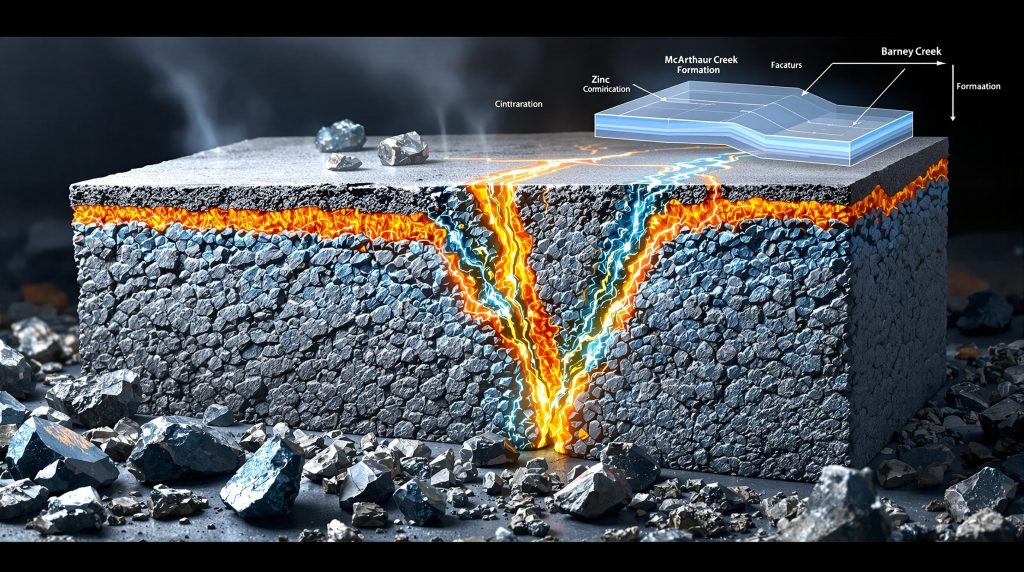What Are Neptunian Dikes and How Do They Form?
Neptunian dikes represent distinctive geological features formed when open fractures in seafloor sediments become passively filled with younger material. Unlike igneous dikes formed through magma injection, neptunian dikes develop when pre-existing cracks and fissures in carbonate platforms fill with sediment from above. These structures range from millimeters to several meters in width and provide crucial windows into ancient tectonic processes.
The formation mechanism involves several key stages:
- Initial fracturing of consolidated or semi-consolidated seafloor sediments
- Maintenance of open fissures through continued tectonic activity
- Passive infilling with sediment, often in multiple episodes
- Cementation and preservation of the filled structures
These structures typically form in extensional tectonic environments where tensional forces create vertical to subvertical fractures. Their presence serves as powerful indicators of syndepositional tectonism, providing insights into stress fields active during basin development.
Distinguishing Features of Neptunian Dikes
Neptunian dikes exhibit several characteristic features that distinguish them from other geological structures:
- Passive infill: Material enters from above rather than being injected
- Multiple fill generations: Often showing complex internal stratigraphy
- Marine cements: Fibrous, radiaxial, and herringbone cement structures lining fracture walls
- Sedimentary structures: Internal lamination and grading within fill material
- Cross-cutting relationships: Different generations of dikes intersecting each other
These features allow geologists to reconstruct the sequence of tectonic events and understand the timing relationships between fracturing, sedimentation, and cementation processes.
Geological Setting of the McArthur Basin and Teena Dolomite
The McArthur Basin represents one of Australia's most significant Paleoproterozoic sedimentary basins, extending across approximately 180,000 square kilometers in the Northern Territory. This intracratonic basin formed through multiple phases of extension and thermal subsidence between approximately 1800 and 1575 million years ago.
The basin's stratigraphic framework comprises four major supergroups:
- Leichhardt Superbasin (1798-1738 Ma)
- Calvert Superbasin (1728-1680 Ma)
- Isa Superbasin (1667-1575 Ma)
- Roper Superbasin (1500-1400 Ma)
The Teena Dolomite belongs to the McArthur Group within the Isa Superbasin, deposited approximately 1640 million years ago. This formation underlies the economically significant Barney Creek Formation, which hosts the world-class HYC (Here's Your Chance) zinc-lead-silver deposit.
Sedimentological Characteristics of the Teena Dolomite
The Teena Dolomite represents a shallow marine carbonate platform sequence characterized by:
- Thinly bedded to laminated dololutite
- Stromatolitic and microbial carbonate facies
- Intraclast breccias and conglomerates
- Dolarenite (dolomitic sandstone) intervals
- Variable silicification
These sedimentary features indicate deposition in environments ranging from restricted lagoons to open marine platforms, with periodic exposure and subaerial diagenesis. The formation shows rapid lateral facies variations that reflect the influence of syndepositional tectonics on depositional patterns.
How Are Neptunian Dikes Distributed in the Teena Dolomite?
Neptunian dikes and associated breccias occur extensively throughout the upper portions of the Teena Dolomite across the Batten Fault Zone region of the McArthur Basin. Detailed stratigraphic analysis reveals that these structures appear at consistent stratigraphic positions across multiple drill cores, indicating a basin-wide tectonic event rather than localized phenomena.
The distribution pattern shows several key characteristics:
- Stratigraphic control: Most abundant in the uppermost sections of the Teena Dolomite
- Regional extent: Documented across numerous localities within the Batten Fault Zone
- Systematic orientation: Consistent directional patterns reflecting regional stress fields
- Spatial association: Close relationship with fault systems and structural lineaments
This widespread distribution suggests a significant basin-scale extensional event occurred around 1640 million years ago, coinciding with the transition from the Teena Dolomite to the overlying Barney Creek Formation.
Textural Classification of Breccias and Dikes
The neptunian dikes and breccias in the Teena Dolomite display a spectrum of textures that reflect different stages of fracturing and infilling processes. These can be classified into:
- Crackle breccias: In-situ fracturing with minimal displacement of fragments
- Mosaic breccias: Moderate displacement with fragments still fitting together like puzzle pieces
- Rubble breccias: Matrix-supported with significant displacement of fragments
- Sediment-filled neptunian dikes: Open fractures filled primarily with sedimentary material
- Cement-lined neptunian dikes: Fractures with walls lined by marine cements
These textural variations provide important clues about the intensity of tectonic activity and the timing relationships between fracturing and sedimentation events.
What Evidence Confirms Their Syndepositional Origin?
Multiple lines of evidence support the syndepositional formation of neptunian dikes and breccias in the Teena Dolomite:
Marine Cement Structures
The fractures typically contain distinctive marine cements lining their walls, including:
- Radial fibrous cements
- Botryoidal cements
- Herringbone cements
These cement types form through rapid precipitation of calcite from seawater and indicate that the fractures were open to the marine environment during formation.
Sedimentary Infill Characteristics
The neptunian dikes contain sedimentary infill that shows:
- Geopetal structures (gravity-controlled sediment distribution)
- Internal lamination and bedding
- Sediment composition matching contemporaneous depositional environments
- Overlapping relationships between cement generations and sediment fill
These features demonstrate that sediment entered the fractures from above while they remained open to the seafloor.
Multi-Phase Development
Complex cross-cutting relationships between different generations of neptunian dikes reveal multiple episodes of fracturing and filling. This pattern indicates repeated tectonic activity during ongoing sedimentation, with earlier dikes being crosscut by later fracturing events. The preservation of these delicate structures suggests minimal post-depositional deformation.
How Do Tectonic Processes Control Neptunian Dike Formation?
The formation of neptunian dikes in the Teena Dolomite reflects a significant extensional tectonic regime active during the Paleoproterozoic development of the McArthur Basin. Rather than representing isolated reef-margin collapse features, these structures indicate basin-wide extensional tectonism.
Extensional Basin Development
Evidence points to a major extensional event around 1640 million years ago that affected the entire Carpentaria Zinc Belt, not just the McArthur Basin. This extension created:
- Regional subsidence and deepening of the basin
- Development of fault-bounded sub-basins
- Formation of fault scarps and associated gravitational instabilities
- Creation of accommodation space for deeper marine sediments
The neptunian dikes represent the initial manifestation of this extensional event, with fracturing of the Teena Dolomite occurring as the basin began to subside.
Progressive Tectonic Evolution
The neptunian dikes record a progressive evolution of the tectonic environment:
- Initial phase: Formation of marine-cemented neptunian dikes in the upper Teena Dolomite
- Transitional phase: Development of sediment-filled neptunian dikes as basin deepening began
- Advanced phase: Formation of debris flows and breccias during continued extension and subsidence
- Final phase: Deposition of deep marine sediments (Barney Creek Formation) in fault-controlled sub-basins
This sequence demonstrates how neptunian dikes serve as sensitive recorders of the evolving tectonic regime, capturing the transition from stable carbonate platform to tectonically active basin.
What Is the Relationship Between Neptunian Dikes and Zinc Mineralization?
The neptunian dikes and breccias in the Teena Dolomite show significant relationships to stratiform zinc mineralization in the McArthur Basin, providing insights into the genesis of these economically important deposits.
Timing Relationship to Mineralization
The extensional event recorded by the neptunian dikes coincides with the timing of major zinc mineralization throughout the Carpentaria Zinc Belt. Geochronological studies indicate that stratiform zinc deposits across the region formed around 1640 ± 10 million years ago, including:
- HYC (McArthur River) deposit
- Teena deposit
- Mount Isa deposit
- Lady Loretta deposit
- Walford Creek deposit
This temporal correlation suggests that the tectonic processes responsible for neptunian dike formation also played a crucial role in creating the conditions necessary for zinc mineralization.
Structural Controls on Mineralization
The neptunian dikes and associated fault systems likely served multiple roles in the mineralization process:
- Fluid conduits: Providing pathways for metal-bearing hydrothermal fluids
- Permeability enhancement: Creating zones of increased porosity and permeability
- Basin architecture: Controlling the development of sub-basins where organic-rich shales accumulated
- Transgressive environments: Facilitating the deposition of reduced, organic-rich sediments crucial for ore formation
The structural framework established during neptunian dike formation created the architectural template that guided later mineralization processes.
How Do the Teena Dolomite Breccias Compare to Other Neptunian Dike Systems?
Comparing the neptunian dikes and breccias of the Teena Dolomite with similar features from other geological settings provides valuable context for understanding their formation and significance.
Comparison with Phanerozoic Examples
While most well-documented neptunian dike systems occur in younger Phanerozoic carbonate platforms, particularly in the Mediterranean region, the Teena Dolomite examples represent some of the oldest known occurrences of these structures. Key comparisons include:
| Feature | Teena Dolomite (Paleoproterozoic) | Phanerozoic Examples |
|---|---|---|
| Age | ~1640 million years | Typically Mesozoic-Cenozoic |
| Tectonic Setting | Intracratonic basin extension | Continental margin extension |
| Host Lithology | Dolomitized carbonates | Primarily limestone platforms |
| Scale | Widespread basin-scale system | Often localized to platform margins |
| Economic Significance | Associated with major zinc deposits | Variable mineral associations |
Despite these differences, the fundamental formation mechanisms appear consistent across geological time, indicating that similar tectonic processes have operated throughout Earth's history.
Unique Aspects of the Teena Dolomite System
Several features distinguish the Teena Dolomite neptunian dikes from other documented examples:
- Their Paleoproterozoic age makes them among the oldest well-preserved examples globally
- The extensive dolomitization of both host rock and dike fills
- Their association with world-class stratiform zinc mineralization
- The basin-wide distribution pattern reflecting regional extensional tectonics
- The preservation of primary textures despite their great age
These unique characteristics make the Teena Dolomite neptunian dikes particularly valuable for understanding both ancient tectonic processes and the genesis of stratiform zinc deposits.
What Are the Implications for Basin Evolution and Mineral Exploration?
The recognition of tectonically-induced neptunian dikes and breccias in the Teena Dolomite has significant implications for understanding both basin evolution and mineral exploration insights in the McArthur Basin and similar geological settings.
Basin Evolution Insights
The neptunian dikes provide crucial evidence for:
- Timing of extension: Constraining the onset of major basin-forming extension to approximately 1640 million years ago
- Regional correlation: Demonstrating synchronous tectonic activity across the broader Carpentaria Zinc Belt
- Transgressive events: Documenting the transition from shallow carbonate platform to deeper marine environments
- Fault reactivation history: Recording multiple phases of tectonic activity through cross-cutting relationships
These insights help reconstruct the complex history of the McArthur Basin and place it within the broader context of Proterozoic crustal evolution in northern Australia.
Exploration Implications
Understanding the relationship between neptunian dikes and stratiform zinc mineralization provides several practical applications for mineral exploration:
- Targeting criteria: Identifying areas with well-developed neptunian dike systems as potential indicators of mineralization
- Stratigraphic positioning: Focusing on the critical transition zone between the Teena Dolomite and Barney Creek Formation
- Structural controls: Mapping fault systems associated with neptunian dike development
- Regional prospectivity: Extending exploration models to other areas with similar tectonic histories
The presence of neptunian dikes may serve as a valuable pathfinder for stratiform zinc deposits, particularly in areas where direct evidence of mineralization is not apparent at the surface.
Reinterpreting the HYC Deposit Context
Recent investigations of neptunian dikes and breccias in the Teena Dolomite have prompted a reexamination of certain geological features associated with the HYC (McArthur River) zinc-lead-silver deposit, one of the world's largest sediment-hosted base metal deposits.
The Cooley Dolomite Breccias
A distinctive breccia unit known as the Cooley Dolomite occurs at the western margin of the HYC deposit. Previously interpreted in various ways, including as:
- A lateral equivalent of the Barney Creek Formation
- A hydrothermal breccia related to mineralization
- A fault-related feature associated with the Western Fault
Recent observations suggest that the Cooley Dolomite breccias may actually represent another occurrence of the Teena Dolomite breccias, based on striking textural and compositional similarities. This reinterpretation has significant implications for understanding the structural setting of the HYC deposit and the timing relationships between tectonism and mineralization.
Revised Structural Model
If the Cooley Dolomite breccias are indeed equivalent to the Teena Dolomite neptunian dikes and breccias, this suggests:
- The Western Fault was active during deposition of the upper Teena Dolomite
- Extensional tectonism preceded and likely controlled the development of the HYC sub-basin
- The structural framework for mineralization was established earlier than previously recognized
- Breccia development represents a regional tectonic event rather than localized hydrothermal activity
This revised model emphasizes the importance of pre-existing structural architecture in controlling both basin development and subsequent mineralization processes.
How Do These Findings Change Our Understanding of Stratiform Zinc Deposits?
The recognition of tectonically-induced neptunian dikes and breccias in the Teena Dolomite provides important insights into the genesis of stratiform zinc deposits in the McArthur Basin and similar settings worldwide.
Implications for Genetic Models
These findings have implications for the ongoing debate between syndepositional exhalative (SEDEX) and epigenetic (Mississippi Valley-Type or MVT) models for stratiform zinc deposits:
- The timing of extensional tectonism coincides with the age of mineralization, supporting a genetic link
- The development of fault-controlled sub-basins created the depositional environments necessary for ore formation
- The preservation of syndepositional structures indicates that basin architecture was established prior to mineralization
- The widespread nature of the tectonic event explains the regional distribution of similar-aged zinc deposits
While not definitively resolving the debate between different genetic models, these observations emphasize the critical role of extensional tectonism in creating the conditions necessary for stratiform zinc mineralization.
Revised Exploration Framework
These insights suggest a revised framework for exploring stratiform zinc deposits that integrates:
- Identification of major extensional tectonic events
- Recognition of neptunian dike and breccia systems as indicators of favorable structural settings
- Focus on transitions between carbonate platforms and deeper basin environments
- Understanding of basin-scale fluid flow systems controlled by syndepositional fault networks
By examining the peripheral geological context beyond the immediate ore deposit, exploration geologists can gain valuable insights into the larger-scale processes that control mineralization. Furthermore, comprehensive soil sampling methods and detailed geological logging codes are essential for identifying these subtle but important features in exploration programs.
Conclusion: The Broader Significance of Neptunian Dikes in the Teena Dolomite
The neptunian dikes and breccias in the Paleoproterozoic Teena Dolomite represent remarkable geological features that provide crucial insights into ancient tectonic processes and their relationship to economically important mineral deposits. These structures record a significant extensional event that affected the entire Carpentaria Zinc Belt around 1640 million years ago, creating the basin architecture that would ultimately host world-class stratiform zinc deposits.
The syndepositional nature of these features, demonstrated by their marine cements, sedimentary infill, and complex cross-cutting relationships, confirms that they formed during active basin development rather than through later processes. This timing coincides precisely with the age of major zinc mineralization throughout the region, suggesting a genetic link between extensional tectonism and ore formation.
By studying these peripheral geological features beyond the immediate ore deposits themselves, geologists gain valuable insights into the larger-scale processes that controlled basin evolution and mineralization. This approach demonstrates the importance of considering the broader geological context when developing exploration models for stratiform zinc deposits. Understanding the relationship between these features and mineralogy and mining economics is crucial for developing effective mineral deposit guide frameworks.
The Teena Dolomite neptunian dikes also provide a rare glimpse into Paleoproterozoic tectonic processes, demonstrating that the fundamental mechanisms of extensional basin development have remained consistent throughout Earth's history. Their exceptional preservation despite their great age makes them particularly valuable for understanding ancient sedimentary basins and their mineral potential.
Want to Be Ahead of the Next Major Mineral Discovery?
Discover why historic mineral discoveries like those in the McArthur Basin can generate substantial returns by visiting Discovery Alert's dedicated discoveries page. Our proprietary Discovery IQ model delivers real-time alerts on significant ASX mineral discoveries, turning complex geological data into actionable investment insights.




